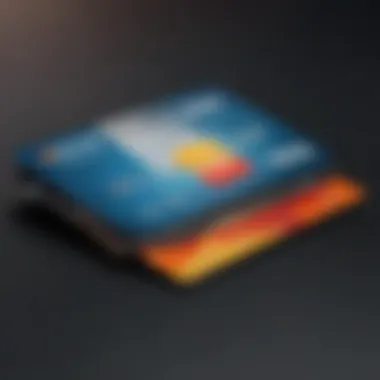Understanding Credit Card Fees and Their Impact


Intro
Credit cards can be a double-edged sword. On one hand, they offer convenience and flexibility, while on the other, they can be riddled with fees that sneak up on unwary users. Understanding these fees is vital for managing your finances successfully. The reality is that many consumers, especially those just stepping into the world of credit, may not grasp the full spectrum of costs involved with credit card usage. To effectively navigate the complexities of credit card fees, one needs a thorough grasp of what these fees entail, why they exist, and how they can impact personal finances.
This article aims to explore the intricacies of credit card fees. We will shed light on everything from annual fees and interest rates to transaction costs. Readers will walk away with insights into how these fees operate, empowering them to make informed choices that can potentially save money in the long run.
Understanding credit card fees isn't just about avoiding penalties; it's about enhancing one’s financial literacy and gaining confidence in financial decision-making.
Prelims to Credit Card Fees
Grasping the intricacies of credit card fees is crucial for anyone stepping into the realm of personal finance. Finance professionals and average consumers alike often overlook this vital aspect, which can substantially impact overall financial health. Understanding these fees not only equips individuals with the knowledge to make informed choices but also contributes to better financial literacy in the long run.
Defining Credit Card Fees
When we talk about credit card fees, we refer to the various charges that financial institutions impose on cardholders for using credit services. These charges can come in several forms, each with its own implications and potential drawbacks. The major categories include annual fees, late payment penalties, cash advance charges, and more.
To give you a clearer picture:
- Annual Fees: This is a yearly charge paid just for having the card. Not all cards have one, but premium cards often do.
- Late Payment Fees: If you forget that due date, expect to pay extra - it’s the card issuer’s way of ensuring they get their money.
- Cash Advance Fees: Need cash quicker than your bank account allows? This option comes with its own set of fees and a higher interest rate.
On top of these, some fees can be more obscure, such as foreign transaction fees or over-the-limit charges. Being aware of what each fee entails promotes better decisions when selecting a credit card, ultimately steering you clear from unnecessary costs.
The Importance of Understanding Fees
Understanding credit card fees provides consumers with leverage. They can compare various credit card offers and weigh the advantages and disadvantages accurately. It’s like arming yourself in a negotiation; knowledge is your strongest ally. Awareness of fees can also prevent the surprises that often arise from unforeseen charges, such as late fees, that can dramatically increase your balance.
Furthermore, if you can pinpoint which fees apply to your spending habits, you can tailor your credit card choice accordingly. For example, if you travel frequently, knowing about foreign transaction fees can guide you toward cards that minimize or eliminate these charges entirely.
"A penny saved is a penny earned." – By comprehending the fees associated with credit cards, consumers can save dollars over time.
In summary, understanding credit card fees is a foundational skill for personal finance enthusiasts, young credit seekers, and informed consumers. Without this knowledge, even the most well-intentioned financial plans can crumble under the weight of unnoticed costs.
Types of Credit Card Fees
When it comes to managing finances, few topics provoke as much confusion and concern as credit card fees. Understanding these fees is crucial not only for making informed decisions when selecting a credit card but also for maintaining a healthy financial profile. It’s easy to overlook the various charges that credit cards can impose, and these fees can accumulate quickly, leading to unexpected costs. A clear grasp of the different types of credit card fees lays the foundation for savvy financial practices and long-term savings.
Credit card fees vary widely among issuers and card types, which means consumers are often left with a daunting task: navigating through a plethora of options. By dissecting the types of fees, one can strategically choose a card that aligns with their lifestyle and spending habits. Let’s take a closer look at some of the most common types of credit card fees you might encounter in today’s financial landscape.
Annual Fees: An Overview
Annual fees are charges that a credit card issuer levies on account holders each year. This fee can range widely, from a modest $20 to an eye-popping $550 for premium cards with extensive perks. It’s easy to dismiss this fee as just another penalty; however, it’s worth considering the value the card offers in return.
For example, a no-annual-fee card might appeal to someone who only uses their credit card occasionally. Yet, a rewards card with a higher annual fee could provide significant value if you travel frequently or make larger purchases. In these cases, benefits such as lounge access, travel insurance, or even cash back can far outweigh the cost of the annual fee.


Late Payment Fees: Consequences of Missed Payments
If you’ve ever forgotten to make a payment, you know that late payment fees can sting. These fees are typically charged when a payment isn’t made by the due date, and they can be as high as $40 per occurrence. Beyond the immediate financial impact, late payments can also have long-lasting effects on your credit score, making it harder to secure favorable terms on loans or additional credit in the future.
Know this: consistently paying late can trigger increased interest rates, sometimes referred to as a penalty APR, which might skyrocket your future payments. It's essential to set reminders or leverage budgeting tools to keep track of your due dates.
Transaction Fees on International Purchases
Planning a trip abroad? Well, you may want to take a closer look at your credit card agreements. Many cards charge a foreign transaction fee, usually around 1% to 3% of each purchase made outside of your domestic currency. While some cards waive these fees, it’s imperative to evaluate yours if you travel frequently.
Using a card with no foreign transaction fees can save you a good chunk of change on your holiday purchases or expenses abroad. Plus, it allows you to enjoy your trip without fixating on how much that latte in Paris is costing you in hidden fees.
Cash Advance Fees: Hidden Costs Revealed
While credit cards can be a convenient payment option, using them for cash advances can quickly lead to a world of hurt. Cash advance fees can typically be a percentage of the amount withdrawn or a flat fee, whichever is higher. This means that if you're in a jam and need quick cash, you could easily find yourself glancing at a withdrawal that costs you 5% of the amount taken out.
But it doesn’t stop there. Interest rates on cash advances often differ from standard purchases—often starting right away without a grace period. The combination of high fees and immediate interest charges makes cash advances one of the costliest options for attaining quick cash.
Over-the-Limit Fees: Understanding the Limits
Though fewer card issuers impose over-the-limit fees today, it’s essential to know the implications of exceeding your credit limit. When you swipe your card beyond your credit line, you could incur a hefty fee—often around $25 to $35—depending on your lender's policies. While some creditors may cover the transaction, it’s often with a financial consequence that can weigh on your wallet.
Understanding your credit limit goes beyond avoiding fees; it also plays a significant role in maintaining a healthy credit utilization rate, which impacts your overall credit score. Keeping spending within limits can help you dodge those surprise fees while contributing positively to your credit profile.
"It’s not just about knowing the fees; it’s about understanding their impact on your finances. One wise choice today can save you a hefty sum tomorrow."
Navigating the landscape of credit card fees may seem overwhelming at times, but being inquisitive and informed can empower you to make better financial choices. By acknowledging the various fees ahead of time, you can develop strategies to minimize their impact, ensuring a smoother path to a more secure financial future.
Interest Rates and Their Impact
Interest rates on credit cards are often the hidden flame that fuels the fire of debt. A misunderstanding of their implications could lead consumers to find themselves in a precarious financial situation. Getting a grip on these rates isn't just a matter of curiosity; it fundamentally influences how much one pays over time and the total cost of borrowing. For those navigating the credit card landscape, knowing about interest rates is crucial, considering that they can significantly amplify the costs associated with purchasing on credit.
Understanding APR and Its Calculation
Annual Percentage Rate, or APR, serves as a financial compass, guiding the consumer in understanding the true cost of borrowing. It encapsulates the interest charged on credit card balances, expressed as a yearly rate. To grasp how APR impacts your finances, it’s essential to comprehend how it's calculated.
- Basic Calculation: APR is calculated by taking the interest you would pay over a year on a balance of $100 and multiplying it. For example, if you had a 15% APR, you would owe $15 on a $100 balance over the course of a year.
- Compounding: Many credit cards calculate interest on a daily basis, which adds a layer of complexity. If you miss a payment, not only do you face late fees, but the interest can accrue faster than expected due to this daily compounding.
- Grace Periods: Understanding the grace period is vital. If you pay off your balance in full during this period, you may avoid interest altogether. However, if you carry a balance, the interest kicks in, and the APR plays a crucial role in the final amount you’ll owe.
The calculation can feel like a complicated dance, but having a clear picture allows you to discern whether a card’s APR is reasonable or a potential financial trap. In the end, a responsible use of credit hinges upon a firm understanding of these numbers.
Variable vs. Fixed Interest Rates
When choosing a credit card, the next question often becomes: Should you opt for a variable or fixed interest rate? This decision is nuanced and can have substantial consequences for your overall financial health.
- Fixed Interest Rates: As the name suggests, fixed rates stay the same over time. This predictability can be comforting, especially if you plan to carry a balance longer than a month. However, it’s crucial to read the fine print, as these rates can potentially escalate after a promotional period.
- Variable Interest Rates: Variable rates, on the other hand, can shift based on market conditions, often tied to an index such as the prime rate. When markets fluctuate, your rate can change, sometimes without notice. This variability can be advantageous if rates fall, but can also lead to unexpected financial burdens.


Understanding the distinction isn’t just academic; it empowers you to make a judicious choice based on your spending habits and financial goals.
"When it comes to credit cards, knowledge is your shield against unnecessary debt. Read up, stay informed, and you won’t regret it."
In summary, the landscape of credit card interest rates is intricate but navigable. With each percentage point carrying potential weight on your financial burdens, getting the lowdown on APR and the differences between fixed and variable rates can save you a significant chunk of change in the long haul.
Comparing Credit Card Fees
When it comes to credit cards, not all roads lead to the same destination. Each card presents its own set of fees, and understanding these differences can be crucial for anyone aiming to manage their finances wisely. Comparing credit card fees enables consumers to make informed decisions that align with their spending habits and financial goals. It’s not just about choosing a card; it’s about understanding the long-term implications of those fees on your overall financial health.
Evaluating Fee Structures Across Different Cards
Diving into the nitty-gritty of fee structures among various credit cards is no small task, but it’s worth every moment spent. For example, while one card might charge a hefty annual fee, it may also offer generous rewards or cashback incentives that can offset that cost. On the other hand, a card with no annual fee might come with more stringent terms, such as higher interest rates or less favorable reward programs.
Here are a few factors to consider when evaluating fee structures:
- Annual Fees: Some cards charge an annual fee for the privilege of accessing premium perks. It's essential to weigh whether the benefits provided justify this fee.
- Transaction Fees: Look into foreign transaction fees if you travel abroad. Some cards waive these fees altogether, while others do not, potentially saving you a pretty penny.
- Late Payment Fees: Many cards impose a late payment fee that can be substantial. It's wise to compare these fees to avoid surprises.
- Cash Advance Fees: If you become entangled in a financial mishap, knowing the cash advance fee can lead to better decision-making during a sticky situation.
In essence, be thorough in your comparisons, and don’t fall for the flashy marketing—get right into the black and white of it.
Choosing the Right Card for Your Needs
Selecting the right credit card involves more than simply picking a card with the fewest fees. It requires a thoughtful consideration of your spending habits, goals, and financial situation. Here are a few tips to guide your decision:
- Analyze Your Spending Patterns: Do you spend more on groceries, travel, or entertainment? Certain cards offer higher rewards in specific categories. Find one that aligns with your lifestyle.
- Consider Your Financial Goals: Are you looking to build credit, or is it more about cashing in on benefits? Your answer should lead your choice.
- Read Reviews: Check user experiences on platforms like Reddit or consumer review sites to see how actual users rate different cards' fees and customer service.
Ultimately, the right card is one that enhances your financial flexibility while minimizing unnecessary costs. It’s about striking a balance between benefits and fees so that you’re not just treading water, but actually moving forward.
"Understanding credit card fees is like having a financial compass. It guides your decisions, helping you avoid hidden pitfalls and steering you toward your financial goals."
Keep these aspects in mind, and you'll find your way through the clutter of credit card offers out there, leading to a path that fits your unique financial landscape.
Strategies to Minimize Credit Card Fees
In the intricate world of credit card management, understanding fees is just one piece of the puzzle. The focus now shifts towards practical solutions—strategies to minimize credit card fees. This section is vital because even the savviest consumer can find themselves ensnared by hidden charges or missed payments that gnaw away at their finances. Knowing how to navigate these waters can spare you from making costly mistakes, allowing you to command your financial destiny.
Negotiating Your Credit Card Terms
When it comes to credit cards, many people underestimate the power of negotiation. Just like haggling at a market stall, discussing terms with your credit card issuer can lead to significantly better deals. Don't shy away from picking up the phone to ask about lower interest rates or waiving annual fees.
- Do your homework: Before initiating negotiations, arm yourself with knowledge about average fees and rates associated t your specific card type. It backs up your case.
- Timing is everything: Aim for a conversation when your payment history is solid. If you've maintained a good payment record, your chances improve dramatically.
- Be polite but firm: A calm demeanor can go a long way, but don’t hesitate to be assertive about your requests.
Remember, a little persistence can open doors you didn't know existed. In a sense, you owe it to yourself to check if your plastic is getting the best treatment.
Timely Payments: Avoiding Penalties


The reality is a simple one: making your payments on time is perhaps the most surefire way to avoid penalties associated with credit cards. A missed payment not only incurs a hefty fee but also negatively impacts your overall credit score. Here's how to make sure you stay on track:
- Set up reminders: Use your smartphone's calendar or a financial app to send you alerts a few days before your due date.
- Automate payments: Most banks allow you to set up automatic payments, ensuring you never miss a beat. Just make sure you have enough funds to cover the payment to avoid overdraft fees.
- Review statements: Familiarize yourself with your billing cycle to anticipate when payments are due. Sometimes people confuse due dates, leading to unintentional oversights.
As the saying goes, "A stitch in time saves nine." Staying punctual with your payments can help you steer clear of dire consequences down the road.
Utilizing Reward Programs Without Incurring Fees
Optimizing credit card benefits is another crucial strategy for minimizing fees. Many credit cards offer attractive reward programs. However, some users rack up fees instead of maximizing the perks, which defeats the purpose. To ensure that you benefit without incurring unwanted costs:
- Read the fine print: Understand how your card’s reward program works. Some cards have limitations on when and how you can redeem your points.
- Don’t rush into redemptions: Wait for valuable opportunities, like cash back offers or discounts that can provide greater value than redeeming your points immediately.
- Update your spending habits: Use your card for regular purchases where you can earn rewards, but only if you can pay off the balance monthly to avoid interest charges.
A reward is of no worth if it's costing you in fees, so always be strategic about your spending limitations.
Real-World Implications of Credit Card Fees
Understanding the real-world implications of credit card fees is crucial for anyone navigating the complex waters of personal finance. These fees can significantly impact one’s financial landscape, affecting everything from budgeting to credit scores. The subtleties involved in credit card costs often go unnoticed until they wreak havoc on consumers’ financial health. Hence, let’s peeled back the layers.
Impact on Credit Scores
Credit scores are a heavy fixture in the game of personal finance. They determine not just the eligibility for loans, but also the interest rates offered to borrowers. Missed payments on credit cards can lead to hefty late fees, and that can drag a credit score down like a stone in water. A single late payment can remain on your credit report for up to seven years, which is a long time in financial terms.
Apart from missed payments, high credit utilization—meaning the ratio of how much credit you’ve used compared to your overall credit limit—can tarnish your score. For instance, if you have a credit limit of $10,000 and you’re carrying a balance of $9,000, you’re utilizing 90% of your available credit, which is a red flag to creditors. In any case, managing various fees—from late payment to over-the-limit fees—will help maintain a healthy credit score.
"Managing credit fees meticulously can be the difference between thriving financially and being stuck in a cycle of debt."
Long-Term Financial Health
When it comes to long-term financial health, the implications of credit card fees are more wide-reaching than they first appear. Racking up fees can quickly spiral into a debt cycle that feels impossible to escape. When consumers fail to understand how these fees accumulate, they often end up paying significantly more over time.
For instance, let’s say you have an annual fee of $95 on a card, compounded by high-interest rates. If you fail to pay off your balance monthly, you’ll find yourself paying not just for the privilege of having the card, but also an ever-growing sum due to interest. Over time, this could amount to thousands of dollars lost.
Moreover, savvy use of credit cards can contribute positively to one's long-term financial goals if managed wisely. Reward programs and cash back offers can be appealing, but only if you’re not buried under a mountain of fees. By maintaining financial discipline and understanding the consequences of credit card fees, individuals can ensure they are not only keeping their expenses low but also building a secure financial future.
Finale
Tying together everything previously explored, it’s evident that understanding credit card fees is paramount. Such knowledge equips consumers—especially those just dipping their toes into credit—with the tools to make informed financial choices. With fees lurking like shadowy figures in the background, being aware of them now means you're not just surviving but thriving in the financial landscape.
Recap of Key Points
- Diverse Types of Fees: We've unraveled the often-complicated web of fees, such as annual, late payment, cash advance, and transaction fees. Each of these can chip away at your finances if you're not careful.
- Impact of Interest Rates: Navigating the differences between variable and fixed interest rates is essential.
- Real-World Implications: It's not just about dollars and cents; these fees can ripple through your credit score and long-term financial health.
- Strategic Minimization: Engaging in practices like timely payments and negotiating fees can turn potentially disastrous financial situations into manageable ones.
Empowering Consumer Choices
When armed with this understanding, consumers can be proactive rather than reactive. Knowledge is your best ally in avoiding the pitfalls of credit card pitfalls. Here are a few ways to harness that power:
- Research and Compare: Take the time to evaluate various credit card offers. Not all cards are created equal, and a keen comparison might uncover better deals.
- Read the Fine Print: Before signing on the dotted line, peruse through all the terms and conditions associated with credit cards. It's boring but essential—skipping this can cost you.
- Stay Informed: Markets shift, and so do offers. Stay abreast of any fees related developments to stay ahead of the game.
"An ounce of prevention is worth a pound of cure." - Benjamin Franklin. This old adage applies ever so fittingly here; being informed helps avoid the financial heartache down the road.
In summary, understanding credit card fees goes beyond mere numbers. It’s about enhancing your financial literacy and making choices that put you in control. With every fee you understand and every strategy you implement, you’re taking steps toward a healthier financial future.















